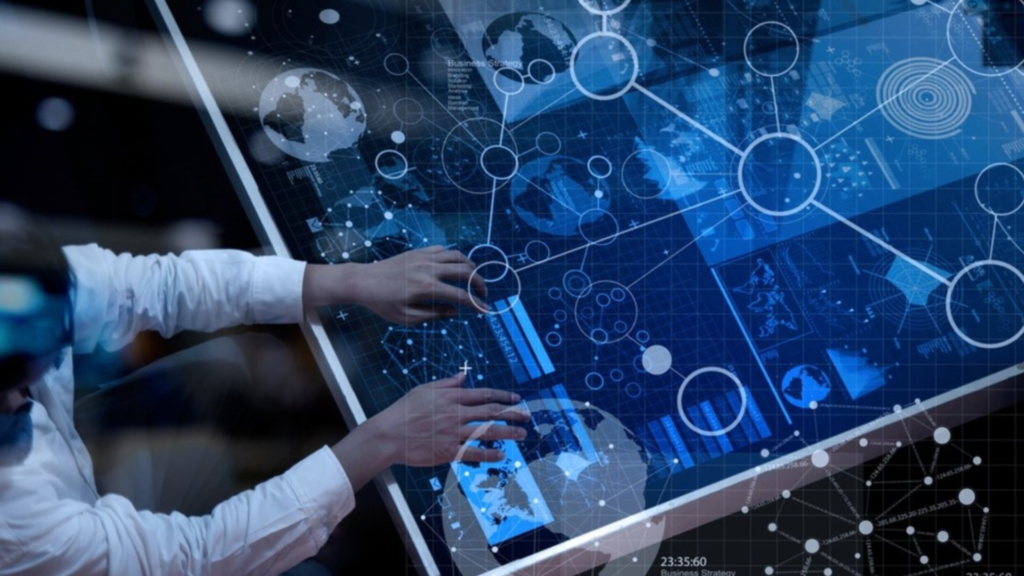Embark on an exhilarating journey into the realm where technology converges with innovation. In this era of rapid progression, staying at the forefront of change is paramount. This article serves as your guide, illuminating the captivating intersections of technology and innovation that are shaping our present and sculpting our future.
From pioneering inventions that transform industries to clever solutions enhancing daily life, the synergy of technology and innovation is undeniable. This powerful pair has revolutionized our lifestyle, work dynamics, and modes of communication, pushing the envelope of their potential. With a concentrated focus on Where Technology Meets Innovation, this article will probe into the latest trends and breakthroughs that redefine the boundaries of the possible.
Whether it’s navigating through state-of-the-art technologies, deliberating over groundbreaking innovations, or scrutinizing the effects of digital transformation, we aim to equip you with insightful knowledge and stimulating viewpoints. Join us as we navigate the ever-changing terrain of technology and innovation. Uncover the trailblazers, understand the disruptors, and deepen your comprehension of how these two elements coalesce to mold our world. Brace yourself to plunge into the domain where technology meets innovation, and anticipate being astounded.
Table of Contents
Role of Technology in Driving Innovation

Technology plays a pivotal role in driving innovation, serving as the foundation upon which new ideas are built and transformative solutions are developed. It is the engine that propels innovation, turning abstract concepts into tangible realities that have the power to change the world.
Innovation is not merely about inventing new technologies; it’s about leveraging these technologies to solve real-world problems and improve lives. It involves applying technology in novel ways to create more efficient processes, develop new products, and deliver better services. From the internet and mobile devices to artificial intelligence and blockchain, technology has been at the forefront of some of the most significant innovations in recent history.
Moreover, technology facilitates the innovation process by providing the tools and platforms necessary for collaboration, research, and development. It enables innovators to connect with each other, share ideas, and work together to bring their visions to life. It also provides access to vast amounts of data and information, which can be used to gain insights, make informed decisions, and drive innovation.
However, the role of technology in driving innovation is not without its challenges. It requires a deep understanding of the technology itself, as well as the ability to foresee its potential applications and implications. It also requires a willingness to take risks, experiment, and learn from failures.
Impact of Innovation on Businesses and Society
Innovation, particularly when fueled by technology, has a profound impact on both businesses and society. It acts as a catalyst for growth and development, fostering economic prosperity and societal advancement.
For businesses, innovation is the key to staying competitive in today’s fast-paced market. It enables companies to improve their products and services, streamline operations, and enhance customer experiences. By adopting innovative technologies, businesses can increase efficiency, reduce costs, and drive revenue growth. Furthermore, innovation fosters entrepreneurship and creates new business opportunities, contributing to job creation and economic development.
On a societal level, innovation has the power to address some of the most pressing challenges we face today. From healthcare and education to sustainability and social justice, innovative technologies are being used to develop solutions that improve quality of life, promote equality, and protect our planet. For instance, digital technologies are transforming education by making learning more accessible and personalized. Similarly, innovations in renewable energy technologies are playing a crucial role in combating climate change.
However, the impact of innovation is not always positive. It can also lead to job displacement due to automation, digital divide, and other societal issues. Therefore, it’s important to foster inclusive and sustainable innovation that benefits all members of society.
Impact of Innovation on Businesses and Society
Innovation is the lifeblood of any thriving society and economy. It is the driving force behind the evolution of businesses, propelling them towards growth and prosperity. When technology meets innovation, it creates a synergy that has a profound impact on businesses and society.
Transforming Business Operations
Innovation, particularly technological innovation, has revolutionized the way businesses operate. It has led to the development of new products and services, improved efficiency, and opened up new markets. For instance, the advent of the internet and digital technologies has enabled businesses to reach a global audience, offering their products and services to customers around the world.
Moreover, innovations in areas such as artificial intelligence and machine learning are automating routine tasks, freeing up human resources for more complex and creative tasks. This not only improves efficiency but also leads to job enrichment and increased employee satisfaction.
Driving Economic Growth
Innovation fuels economic growth by creating new industries and rejuvenating existing ones. The technology sector is a prime example of this, with companies like Apple, Google, and Microsoft becoming some of the most valuable companies in the world due to their innovative products and services.
Furthermore, innovation stimulates competition as businesses strive to outdo each other in developing the next big thing. This competition drives further innovation, creating a virtuous cycle of growth and development.
Enhancing Quality of Life
On a societal level, innovation has the power to enhance our quality of life in countless ways. From healthcare to education, technology has made services more accessible and effective. Innovations in healthcare technology, for example, have led to advancements in medical treatments and diagnostics, improving patient outcomes and extending life expectancy.
Major Technological Trends That Are Driving Innovation
In the dynamic landscape of the 21st century, technology and innovation are intertwined in a symbiotic relationship. Here are some major technological trends that are currently driving innovation:
Artificial Intelligence (AI) and Machine Learning (ML): AI and ML are revolutionizing various sectors by automating complex tasks, predicting patterns, and personalizing user experiences. They are the backbone of innovations like autonomous vehicles, smart homes, and advanced healthcare systems.
Internet of Things (IoT): IoT is enabling devices to communicate and interact over the internet, and remotely be monitored and controlled. It has led to the development of smart cities, industrial automation, and connected health devices.
Blockchain Technology: Originally devised for digital currency, blockchain has found potential uses in decentralized, secure information sharing, making it a game-changer for sectors like finance, supply chain, and healthcare.
5G Technology: The advent of 5G is accelerating the speed and efficiency of data transfer, paving the way for advancements in virtual reality, augmented reality, and IoT.
Quantum Computing: With the potential to solve complex problems that are currently beyond the reach of classical computers, quantum computing could bring about breakthroughs in material science, optimization, and AI.
These trends are not only shaping the trajectory of technological growth but also fostering an environment that encourages innovative thinking and problem-solving. As we continue to explore these technologies, we can expect a future where technology and innovation seamlessly merge to transform our lives.
How Businesses Can Embrace Technology to Foster Innovation

In the era of digital transformation, businesses can leverage technology to foster innovation in several ways:
Adopting Emerging Technologies: Businesses should stay abreast of the latest technological trends such as AI, ML, IoT, blockchain, and 5G. These technologies can be integrated into business operations to streamline processes, enhance customer experiences, and create new business models.
Fostering a Culture of Innovation: Encouraging a culture that embraces change and values creativity is crucial. This involves promoting a growth mindset, encouraging risk-taking, and rewarding innovative ideas.
Investing in Research & Development (R&D): Businesses should invest in R&D to explore new technologies and their potential applications. This can lead to the development of innovative products and services that provide a competitive edge.
Collaborating with Tech Startups: Partnerships with tech startups can provide businesses with access to innovative ideas and cutting-edge technologies. This can accelerate the pace of innovation and provide mutual benefits.
Upskilling Employees: Providing employees with training in new technologies can equip them with the skills needed to drive innovation. This not only enhances their productivity but also boosts their morale and job satisfaction.
Case Studies of Successful Companies That Have Used Technology to Drive Innovation
Let’s explore some case studies of companies that have successfully used technology to drive innovation:
Amazon: Amazon has consistently been at the forefront of innovation, leveraging technology to revolutionize retail. From pioneering e-commerce to introducing AI-powered solutions like Alexa and Amazon Go, Amazon’s innovative use of technology has set new standards for customer experience.
Tesla: Tesla has disrupted the automotive industry with its electric vehicles. By integrating advanced technologies like AI, IoT, and machine learning, Tesla has been able to innovate in areas like battery technology, autonomous driving, and user experience.
Netflix: Netflix transformed the entertainment industry by leveraging technology to offer a personalized, on-demand streaming service. Their use of big data and AI to drive content recommendation is a prime example of technological innovation.
Airbnb: Airbnb used technology to create a peer-to-peer marketplace for accommodation, disrupting the traditional hospitality industry. Their innovative use of digital platforms, mobile technology, and data analytics has enabled them to offer a unique, personalized user experience.
Spotify: Spotify has revolutionized the music industry with its streaming service. Their use of AI and big data for personalized recommendations has set them apart in a competitive industry.
These companies demonstrate how embracing technology can drive innovation, disrupt industries, and deliver value to customers.
Challenges of Implementing Technology-Driven Innovation
In the realm where technology meets innovation, one of the most significant hurdles is the implementation of technology-driven innovation. This process is fraught with challenges that can be broadly categorized into three areas: technical, organizational, and societal.
Technical Challenges
The first set of challenges are technical in nature. These include issues related to the complexity of new technologies, their integration with existing systems, and the need for technical skills to manage and operate them. For instance, implementing artificial intelligence (AI) in a business requires not only sophisticated AI models but also the infrastructure to support these models and the data they need to function effectively.
Organizational Challenges
The second set of challenges are organizational. These involve the changes that a company must make to its structures, processes, and culture to accommodate new technologies. For example, adopting agile methodologies requires a shift from traditional hierarchical structures to more flexible, team-based ones. Similarly, leveraging big data necessitates changes in how data is collected, stored, and analyzed within the organization.
Societal Challenges
Finally, there are societal challenges. These encompass the broader impacts of technology-driven innovation on society, including ethical, legal, and social implications. For instance, the use of AI and automation raises questions about job displacement and privacy, while the deployment of innovative technologies in sectors like healthcare or education requires careful consideration of issues like equity and access.
Strategies for Overcoming Barriers to Technology-Driven Innovation
Overcoming the barriers to technology-driven innovation requires a strategic approach that addresses the technical, organizational, and societal challenges. Here are some strategies that can be employed:
Addressing Technical Challenges
To overcome technical challenges, organizations can invest in training and development to equip their teams with the necessary skills to handle new technologies. They can also seek external expertise through partnerships and collaborations. Additionally, adopting a phased approach to implementation can help manage the complexity and integration issues associated with new technologies.
Tackling Organizational Challenges
Organizational challenges can be addressed by fostering a culture of innovation within the organization. This involves encouraging experimentation, accepting failure as part of the learning process, and rewarding innovative ideas. Implementing change management practices can also help ease the transition to new structures and processes.
Mitigating Societal Challenges
Societal challenges require a more holistic approach. This includes engaging with various stakeholders, including employees, customers, and the wider community, to understand their concerns and address them. Ethical considerations should be at the forefront of technology implementation, with clear policies on issues like data privacy and job displacement.
Leveraging Innovation Frameworks
Frameworks such as Design Thinking, Lean Startup, and Agile can provide structured approaches to innovation, helping organizations navigate the path from idea to implementation. These frameworks emphasize customer-centricity, rapid prototyping, and iterative development, which can be particularly useful in the context of technology-driven innovation.
Future of Technology and Its Potential for Driving Innovation
As we look towards the future, the intersection of technology and innovation promises to be a dynamic and transformative space. Here are some key trends and their potential for driving innovation:
Artificial Intelligence (AI) and Machine Learning (ML)
AI and ML are set to revolutionize various sectors, from healthcare to finance, by automating tasks, providing insights from large datasets, and enabling more personalized services. The potential for innovation lies in the development of more sophisticated algorithms, the creation of AI that can learn without supervision, and the ethical use of AI.
Internet of Things (IoT)
The IoT, which involves connecting physical devices to the internet, has the potential to transform our daily lives. From smart homes that increase energy efficiency to wearable devices that monitor health, the IoT offers numerous opportunities for innovation.
Blockchain Technology
Blockchain technology, best known for cryptocurrencies like Bitcoin, has potential far beyond finance. Its ability to create secure, transparent transactions could innovate sectors like supply chain management, healthcare, and governance.
Quantum Computing
Quantum computing, which leverages the principles of quantum mechanics, has the potential to solve complex problems that are currently beyond the reach of classical computers. This could drive innovation in areas like material science, optimization problems, and cryptography.
Virtual and Augmented Reality (VR/AR)
VR and AR technologies can create immersive experiences that have applications in gaming, education, and remote work. The future may see innovations in the form of more realistic virtual environments and seamless integration of digital information into the physical world.
Resources and Tools for Businesses Looking to Harness Technology for Innovation

In the journey of harnessing technology for innovation, businesses can leverage a variety of resources and tools. Here are some key ones:
Educational Resources
Knowledge is the foundation of innovation. Online platforms like Coursera, edX, and Khan Academy offer courses on various technologies. Websites like TechCrunch, Wired, and MIT Technology Review provide the latest news and insights into emerging technologies.
Innovation Frameworks
Frameworks such as Design Thinking, Lean Startup, and Agile provide structured methodologies for innovation. They guide businesses in ideation, prototyping, and implementation, helping them effectively use technology for innovation.
Collaboration Tools
Tools like Slack, Microsoft Teams, and Google Workspace facilitate communication and collaboration within teams, which is crucial for innovation. Version control systems like Git and project management tools like Jira support the development and management of technology projects.
Cloud Platforms
Cloud platforms like AWS, Google Cloud, and Microsoft Azure provide businesses with the infrastructure to develop, deploy, and scale applications. They offer services related to AI, ML, IoT, and more, enabling businesses to experiment with these technologies without significant upfront investment.
Open Source Software
Open source software provides businesses with a cost-effective way to leverage existing technology. GitHub is a popular platform for finding open source projects. Libraries and frameworks for AI (like TensorFlow and PyTorch), web development (like React and Angular), and more are available for businesses to use.
Data Analysis Tools
Tools like Python, R, and SQL, along with libraries like pandas and NumPy, are essential for analyzing data and gaining insights. Visualization tools like Tableau and PowerBI help in presenting these insights in an understandable manner.
FAQs About Where Technology Meets Innovation
What is meant by Where Technology Meets Innovation?
Where Technology Meets Innovation refers to the intersection of technological advancements and innovative practices. It’s a space where new technologies are leveraged to create novel solutions, disrupt traditional industries, and drive societal progress.
Why is technology important for innovation?
Technology is a key driver of innovation. It provides the tools and platforms that enable new ways of doing things, from improving efficiency and productivity to creating entirely new products and services.
What are some examples of technology-driven innovation?
Examples of technology-driven innovation are abundant and span various sectors. They include AI-powered personalized recommendations in e-commerce, blockchain technology in finance, IoT in smart homes, and telemedicine in healthcare.
What are the challenges in implementing technology-driven innovation?
The challenges include technical issues like system compatibility and skill requirements, organizational hurdles like resistance to change and lack of vision, and societal concerns like ethical implications and regulatory constraints.
How can businesses overcome these challenges
Businesses can overcome these challenges through strategies like continuous learning, fostering an innovative culture, stakeholder engagement, ethical considerations, and leveraging innovation frameworks.
What is the future of technology and its potential for driving innovation?
The future of technology holds immense potential for driving innovation with emerging technologies like AI, ML, IoT, blockchain, quantum computing, and VR/AR leading the way. These technologies are set to revolutionize various sectors and create unprecedented value.
What resources and tools can businesses use to harness technology for innovation?
Businesses can leverage educational resources, innovation frameworks, collaboration tools, cloud platforms, open-source software, and data analysis tools to harness technology for innovation. These resources equip businesses with the knowledge and capabilities needed to navigate the path of technology-driven innovation.
Conclusion
The intersection of technology and innovation is a dynamic and transformative space. It is here that we see the most significant advancements in our society, driven by the relentless pursuit of better solutions to existing problems and the creation of unprecedented opportunities.
However, the journey is not without its challenges. From technical hurdles to organizational changes and societal implications, the path to technology-driven innovation is complex. Yet, with the right strategies, resources, and tools, these challenges can be navigated successfully.
The future of technology holds immense potential for driving further innovation. Emerging technologies such as AI, ML, IoT, blockchain, quantum computing, and VR/AR are set to revolutionize various sectors and create unprecedented value. Businesses that can harness these technologies effectively will be at the forefront of this transformation.
In conclusion, Where Technology Meets Innovation is not just a concept, but a reality that is shaping our world. It is a testament to human ingenuity and the power of technology to drive progress. As we continue to explore this exciting intersection, we can look forward to a future filled with endless possibilities and innovations.
Recommended: Is Fire Considered Technology?

